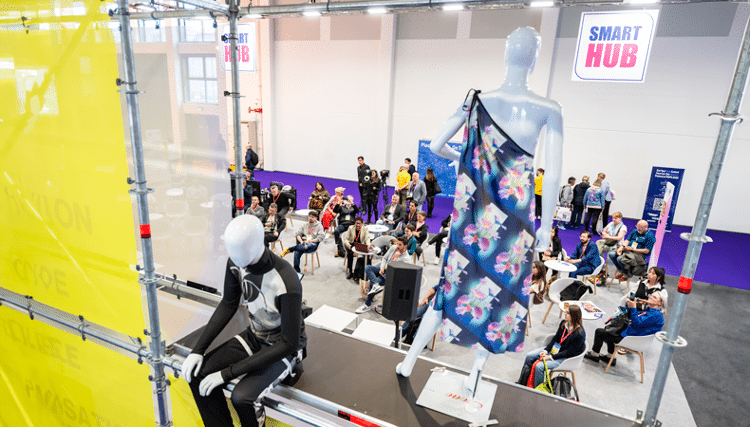The intelligence behind the ink: how AI is changing printing forever

Keypoint Intelligence, the global market data leader for the digital imaging industry, showed the growing application of artificial intelligence to all facets of printing at the SmartHub Conference at the Personalisation Experience 2025, co-located at the FESPA Global Print Expo earlier this month.
What is the true benefit of AI? Put simply, according to Keypoint Intelligence: it enables faster decisions. It saves time, it minimises waste, and it elevates the entire customer experience. Printers who adopt AI will be more agile and probably more profitable. And as AI moves from a reactive to a proactive role in workflows, it is a question of: can you afford not to invest?
Specialising in every segment of print, from wide format to commercial textiles, packaging and labels, Keypoint Intelligence offers the most comprehensive independent data, research and thought leadership in the industry and is uniquely positioned to analyse the most disruptive force in the market at present: AI.
AI is the answer to perennial print industry problems: skilled labour shortages, cost pressures, inconsistent quality and the new burden of mandated sustainability metrics
At the SmartHub conference at the Personalisation Experience, co-located at the FESPA Global Print Expo held in Berlin in May, Lisa Brown and Johnny Shell, principal analysts at Keypoint, described how AI was already being integrated in key areas along the value chain: from design and pre-press to customer service and delivery. AI is also the answer to perennial print industry problems: skilled labour shortages, cost pressures, inconsistent quality and the new burden of mandated sustainability metrics.
Lisa and Johnny pointed out that some, if not all, of a printer’s providers and vendors are already leveraging AI. Today, AI is streamlining the design stage, allowing users to automatically sharpen and update images for improved quality. At the pre-press stage, AI-powered prediction tools are helping forecast issues in advance before they occur and configuring job and resource planning. In the production phase, optimisation tools are driving efficiencies within the production scheduling and job planning. In post-production, inspection and quality control are leveraging machine learning to help detect defects early. Finally, in the customer service and delivery point in the value chain, AI-driven personalisation is key in targeting personalised outputs and a better customer experience.
So AI is already widely adopted in the sector and is being tested and integrated particularly in areas such as file preparation and colour management. But looking ahead, what areas will see most growth when it comes to maximising the use of AI?
Keypoint research shows that applications that see only limited use at present, such as predictive analytics and maintenance, dynamic workflow automation and real-time monitoring will be standard across the industry in a couple of years. And AI will flow into a variety of applications and workflow stages, including sales, marketing and business development. Those standing on the sidelines may be left behind if they are not considering keeping up with their AI-using competitors.
Digital textile printing
As an example, Brown and Shell dug deeper into AI’s delivery of targeted value in digital textile printing. Smart file optimisation allows adjustment for fabric types and colour gamuts. Automated job routing improves throughput and resource allocation. AI driven print management minimises human error and balances capacity dynamically. And these systems fully streamline output, enabling the scale-up of production without adding complexity. AI uses sensor data and patterns from production hardware that anticipate component failure to reduce unplanned downtime, which is a major cost factor in many high throughput operations.
The AI system continuously monitors printhead performance, fabric movement and curing parameters to ensure consistent quality and proactively prevent errors
Kornit Digital's Atlas Max exemplifies this shift towards intelligence through embedded analytics in textile printing. The AI system continuously monitors printhead performance, fabric movement and curing parameters to ensure consistent quality and proactively prevent errors. AI-driven modules dynamically adjust ink and cure settings based on the garment type and environmental conditions in real time, while predictive maintenance alerts reduce downtime. Operators of the Atlas Max can gain real-time insights into productivity, ink usage and print profitability. This functionality results in higher first-time print accuracy, reduced waste and significantly fewer operator interventions.
Areas of AI expansion
Keypoint saw four prime areas where AI will expand.
-
Generative AI for design and marketing
Instant content creation will lead to faster production and hyper-personalised, mass-customised campaigns. Already, there is a 30% to 50% faster design turnaround when using AI, and exceptional colour management algorithms are improving colour consistency across different substrates, so personalisation at scale will no longer be a bottleneck. -
Sustainability
AI is instrumental in enabling printers to track sustainability metrics and meet ESG goals. It can calculate emissions for every job based on material use and energy consumption rather than relying on manual audits or after the fact reporting. AI systems can fine-tune dryer settings, ink volumes and machine settings to reduce resources and automate ESG reporting. The outcome? A streamlined sustainability audit with a stronger brand reputation, better client trust and greater compliance with the evolving regulations like the EU Green Deal or the circular economy initiatives. -
Automated print shop orchestration
AI will move beyond isolated tools into full orchestration of the entire production environment, where it not only automates tasks but also makes high-level decisions and optimises operations from start to finish. With intelligent job routing, AI can assign print jobs to the most suitable devices based on material compatibility, current workload, ink availability, and it can simulate production scenarios to pre-emptively optimise shiploads, ink usage, substrate consumption and energy costs before the jobs actually run. The expected outcome is increased throughput and surface level agreement adherence, reduced operator dependency for scheduling and improved responsiveness to sudden job changes or rush orders. -
AI + IoT for connected print shops
We can expect a smarter and more connected print shop. All of a print shop’s hardware, software and other disparate systems, across multiple regions or locations, will be centrally connected. One example is predictive maintenance, when the AI diagnoses and predicts failures in advance before they happen. The monitoring and alerts will only become more advanced with remote real-time diagnostics, remote diagnostics of device issues, as well as proactive remediation off-site. Advanced consumables monitoring (inks, papers, fabrics) will be monitored and smart replenishment cycles will reduce downtime. All of this will probably be integrated in a more advanced data dashboard so printers can centrally control their environment to make better decisions about their business.
“The future is about convergence,” said Johnny Shell. “Smart factories are no longer theoretical. They’re being built with AI and IoT integration at the core. The print shop of the future is not just smart, it's autonomous.”
Become a FESPA member to continue reading
To read more and access exclusive content on the Club FESPA portal, please contact your Local Association. If you are not a current member, please enquire here. If there is no FESPA Association in your country, you can join FESPA Direct. Once you become a FESPA member, you can gain access to the Club FESPA Portal.
Recent news

Sustainability, seaweed and storytelling
Joanne O’Rourke, winner of the Epson Design Award, discusses the interface between storytelling, nature, craft and innovation in her business, and how the Personalisation Experience 2025 was a career-defining moment.

What’s new in stamping foils? Bringing extra sparkle to print products
Stamping foil can help your products to really stand out – and you can probably do it with the equipment you already have. We speak to Matt Hornby of foil specialists Foilco.

Regulation guidance: CS3D
How does the Corporate Sustainability Due Diligence Directive (CS3D) affect printers, and what do they need to do to ensure compliance? Sustainability consultant Rachel England outlines everything you need to know.

How to choose the best courier for safe shipping
As a printer, making sure your work is high-quality is only half the job – delivering to the customer on time and intact is just as important. Reliable courier services are vital for your business reputation, so here’s what to look for in a delivery partner, and why automation may be one way you can boost your business.